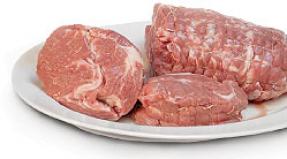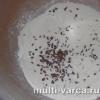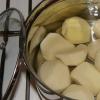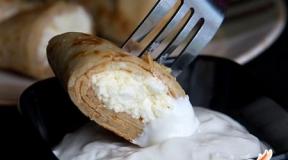How to properly cook kombucha at home. How to grow kombucha from scratch right at home
Many housewives prepare a drink made from kombucha or jellyfish. It has an interesting taste, good thirst quencher and many health benefits. The easiest way to propagate a kombucha colony is to separate the layer from the existing one. But if this is not possible, kombucha is grown from scratch. Popular recipes based on black or green tea, rose hips, or other available options are suitable for this.
- activates metabolism due to the content of lipase and amylase, which are involved in the breakdown of fats, starch and accelerate the absorption of protein;
- improves the activity of the digestive system and pancreas;
- relieves inflammation in the oral cavity, helps to treat throat diseases, eliminates bad breath;
- promotes the treatment of the common cold;
- heals purulent wounds, burns, boils and other damage to the skin;
- helps to normalize blood pressure, reduces the amount of bad cholesterol, improves the functioning of the cardiovascular system;
- rejuvenates the skin, tightens pores and cleanses them;
- promotes the treatment of eye diseases;
- helps to lose weight.
- 1. A jar for disinfection is poured over with boiling water.
- 2. Separately brew strong tea, adding 2-3 tbsp for each liter of boiling water. l. dry tea leaves. The drink is insisted for at least 20 minutes.
- 3. Strain the tea and pour it into the prepared jar. Pour 4 tbsp. l. granulated sugar and mix thoroughly until the grains are completely dissolved.
- 4. The jar is not closed with a lid, but tied around the neck with several layers of gauze to protect the kombucha from dust and to provide fresh air for fermentation.
- 5. The bank is placed in a warm place for 1.5–2 months. During this time, a dense film with a thickness of about 2 mm is formed on the surface of the liquid, which is also a kombucha.
- 6. Ready-made kombucha, resembling a jellyfish in its appearance, is carefully removed from the jar, washed thoroughly and used to obtain new portions of the drink.
- 1. First, prepare an infusion based on fresh or dried rose hips. Thoroughly washed raw materials in the amount of 4 tbsp. l. put in a thermos and add 500 ml of boiling water. The thermos is closed and left to infuse for 5 days.
- 2. Then the infusion is poured into a thoroughly washed glass jar. Add 2 tbsp. l. dry brewing of black tea.
- 3. Pour in 50 g of granulated sugar and mix thoroughly until the sugar dissolves.
- 4. After a day, filter the resulting infusion and pour it into a clean jar, in which the kombucha will be prepared. The neck of the jar is tied with clean gauze and the container is left for 1.5–2 months in a warm room at home, protected from direct sunlight.
Show all
What is Kombucha?
In fact, kombucha has nothing to do with real mushrooms and has nothing to do with tea. The body of the fungus consists of several layers of a mucous membrane formed as a result of the symbiosis of acetic acid bacteria and yeast-like fungus. For the existence of this living organism, a nutrient medium is needed, which is provided by sweetened tea or berry-fruit juice.
The yeast contained in the colony converts sugar into ethyl alcohol and carbon dioxide, and bacteria oxidize alcohol and convert it into acetic acid. The result is a drink with a sweet and sour taste, somewhat reminiscent of bread kvass.

Tea mushroom
Another name for kombucha is jellyfish or kombucha. Its exact origin is unknown. In the first years of its appearance in the country, the drink did not enjoy much love. Now he is gaining more and more fans. This is explained not only by a pleasant refreshing taste, but also by useful medicinal properties. So, kombucha:

How to Grow Kombucha from Scratch?
The process of growing kombucha from tea takes an average of 1.5–2 months. This will require a glass jar with a volume of at least 3 liters, sugar and dry tea leaves.
The growing procedure looks like this step by step:
For the successful cultivation of jellyfish, a jar of tea infusion must be kept in a room with a temperature of at least +25 degrees, but not placed in direct sunlight. You can speed up the fermentation process by adding 1/10 of the total liquid apple cider vinegar to the jar.
After 1 or 2 weeks after the start of growing the jellyfish, a vinegar smell will appear, which will disappear after another 7 days. This indicates that the formation process is going well.

How do I get a drink?
After the first layer of kombucha has been grown, it can be used to make a healthy drink. To do this, brew ordinary black or green tea without additives in the amount of 2 tsp. tea leaves for 1 liter of boiling water. Sugar is added to the finished brew to taste, but not more than 50 g, and stirred until the crystals are completely dissolved. After cooling the tea infusion to room temperature, it is filtered and poured into a jar.
The container for preparing a drink from kombucha must be absolutely clean, otherwise mold will appear in the can, which will not only spoil the drink, but also destroy the jellyfish itself.

Kombucha is removed from the jar carefully so as not to damage its integrity.
A grown layer of kombucha is placed in a container and the jar is covered with clean gauze folded in several layers. The jar is placed in a warm place, out of direct sunlight. After 7-10 days, the drink will be ready.

Rosehip
There is another way to germinate kombucha using rosehip decoction. The resulting drink is useful to drink in the off-season to improve immunity, saturation of the body with useful substances and vitamins. The cooking recipe in this case is only slightly different from the traditional one:
Possible problems
It is not always possible to grow jellyfish without problems. The reasons for failure can be different, but in most cases the situation can be corrected by replacing the tea leaves.
Possible problems and solutions:
| Problem | Cause | How to fix |
| Does not turn sour | Unsuccessful composition of the nutrient medium | The mushroom must be washed and placed in a fresh nutrient solution, made according to all the rules |
| No gassing occurs | The drink has stood or is in the sun | The mushroom should be washed and a new portion of the infusion should be prepared, or simply remove the jar from the lighted place. |
| The mushroom sank to the bottom | It needs to get stronger or it has deteriorated | If the color of the medusomycete has not changed, then you need to wait until the mushroom gets stronger and floats again. If the film turns brown, then the mushroom has deteriorated and it is better to throw it out. |
| The drink has darkened | The liquid was not drained for a long time, which led to an increase in the amount of acetic acid and a lack of nutrients | To solve the problem, you can add sugar to the nutrient solution or rinse the mushroom, remove the darkened layers and place in a fresh portion of the nutrient medium. |
| Mold has formed | Dirt or insects have entered the vessel | This drink should not be consumed. Kombucha needs to be rinsed and damaged layers removed. Then it is placed in a fresh portion of the nutrient solution. After 7 days, this portion of the drink is drained, and the next one can be drunk. |
Medusomycete care
Kombucha is a living organism that needs some care for a long life. All utensils used to prepare and store the drink must be clean so that mold does not form, destroying all the beneficial properties of kombucha. In this case, the drink acquires an unpleasant vinegar aftertaste, and the mushroom itself deteriorates.
Healthy kombucha is in the top layer of the liquid, not sinking into the middle or the bottom. If this happens, the mushroom is removed from the jar, washed thoroughly with clean filtered water and a new portion of the tea infusion is prepared according to all the rules.
Initially, the mushroom is grown in not a large number liquids. Over time, it grows and it requires a larger volume of nutrient medium, so the volume of liquid is gradually brought to 3 liters. To do this, simply add a fresh batch of tea leaves prepared according to the original recipe. In this case, it is important not to allow the sugar crystals to come into contact with the fungus, this can cause a burn. Therefore, first the solution is thoroughly mixed until the sugar is completely dissolved, and only then it is added to the jar with kombucha.

Kombucha needs to be washed regularly
Every month, the kombucha must be rinsed under running water. To do this, carefully take it out of the can, trying not to damage it, and put it in a flat plate. After washing, the film is left in the air for 2 minutes and then placed back in the jar.
Over time, the kombucha grows new layers, so when its thickness exceeds 4 cm, the excess is separated and placed in another jar with fresh tea leaves. The shelf life of a drink prepared with one portion of the infusion does not exceed 30 days. It then takes on a vinegar aftertaste and can only be used for external use. Therefore, it is recommended to prepare a new batch of tea leaves every month. This process can be combined with flushing.
The first time the mushroom needs to be poured with strong tea (without tea leaves) with sugar, not hot, you can use a slightly warm room. temperature, about 0.5 liters. As the mushroom grows, the liquid must also be added.
If you took a wide thermos, and the jar where you put the mushroom and where it will live is narrow, then after 2 weeks you can drink. And if the thermos is thin and the jar is large and the mushroom has grown in diameter and thickness not much in the thermos - wait until it grows in the jar, because there will be no sense from the drink in view of the discrepancy between the proportions of the size of the mushroom and the liquid poured into it. It is important. It's only about proportions.
***
TEA MUSHROOM CARE
Growing kombucha at home from scratch is half the battle. The second equally important half is proper care of the mushroom. Otherwise, you risk not getting a delicious drink, but something that resembles vinegar. And even worse - the kombucha grown with such care will simply die.
By the way, there is an excellent indicator of the health of kombucha - it should always be on the surface of the water. If your mushroom has sunk to the bottom, or refuses to float up again after refilling the tea leaves, it is very likely that it is sick. If the kombucha gets sick, you have made a care mistake. This means that it must be treated, and in all cases, without exception, the treatment is the same - cleanliness and proper care.
Liquid volume
As you remember, initially there is a small amount of liquid in the jar - about 0.5 liters. But when the mushroom has already grown, there should be much more liquid - about three liters. It goes without saying that your kombucha is not a decoration item and you will drink it. So, do not forget to regularly top up fluid.
To do this, you can use an already dormant tea leaves - pour boiling water over it, cool and add sugar, then pour into a jar. Sugar should not be very much - no more than two tablespoons per liter of liquid. It is best to add sugar to the cup of your drink if needed.
A lot of people don't filter the tea leaves - they just add it. For the mushroom, there is no harm in this, it will just not be very convenient for you to drink the drink later. But there will be no harm only if all the sugar is completely dissolved - the sugar grains should in no case come into contact with the surface of the mushroom.
Bath day
Once every two to three weeks, be sure to arrange a bath day for the kombucha. Remove the mushroom itself from the jar very carefully, put it on a wide plate, trying not to deform it too much. Thoroughly strain the liquid containing the mushroom with a gauze cloth and pour into a clean three-liter jar.
Place the plate with the mushroom in the sink and gently rinse with warm (but not hot) water, leave in the air for a couple of minutes. Then, also carefully transfer the kombucha to the jar and cover with a gauze cloth. That's all, the "headwash" of kombucha is over. It would seem that it is a completely simple procedure, which is very simple to do, and it is thanks to it that your kombucha will be healthy.
Otherwise, the mushroom will start to hurt - at first it will acquire a brown tint, and then it will begin to exfoliate altogether. It is very difficult to save such a mushroom, and in most cases it is easier to grow a new one. And it is generally not recommended to drink a drink from such a kombucha, because it not only loses its benefits, but moreover, it becomes dangerous to health. Remember that the infusion of kombucha should always be extremely clear.
Kombucha storage
Another prerequisite for the health of kombucha is proper storage. Firstly, the temperature - it should be high enough only when growing kombucha. Then the optimum temperature should not exceed 18 degrees. Secondly, the illumination. For the normal functioning of the Kombucha, light is simply necessary, and the daylight hours should be at least 8 hours. But direct sunlight must be avoided, so don't make the very common mistake of placing the jar of kombucha on the windowsill.
The benefits of kombucha
It is impossible not to at least briefly mention the beneficial properties of kombucha - is it not in vain, after all, you are messing with it?
»Metabolism and the immune system
The first thing worth mentioning is vitamins. Kombucha contains many more nutrients than the most expensive vitamin and mineral complex. Vitamins, minerals, carbonic, lactic and other acids, minerals, enzymes - this is not a complete list. Therefore, it is not surprising that a drink made from kombucha has the most positive effect on the functioning of the immune system and normalizes metabolism.
»Digestive tract
Gastritis, colitis, gastric ulcer and duodenal ulcer, dysbiosis.
Just one glass of kombucha drink taken on an empty stomach can improve the situation in just a week. And its regular use contributes to a complete cure. By the way, the drink eliminates even the most severe heartburn very well.
As you can see, there is nothing difficult in growing and caring for kombucha. Therefore, if you set out to grow this miracle mushroom yourself - go for it, because the benefits are obvious!
Everyone at least once had to meet this miracle in a bank.
Its discoverers, the Japanese, call it seaweed.
In our open spaces, it got the name - kombucha.
Outwardly, it resembles an ever-growing jellyfish.
Smooth on top and loose on the bottom, where a huge number of yeast bacteria are located, which are involved in the fermentation process.
How is Kombucha used at home? Its benefits for the body
The use of kombucha tincture can be classified as alternative medicine. With its help, they get rid of various diseases and prevent their recurrence:
Sleep disturbances and insomnia;
Headache;
Unstable blood pressure;
Stress and loss of energy;
Chronic rhinitis;
Chronic tonsillitis;
Diseases of the gastrointestinal tract;
Kidney disease;
Liver disorders;
Diseases of the genitourinary system;
Disturbances in the work of the cardiovascular system;
Rheumatic heart disease;
Polyarthritis;
Atherosclerosis.
Using kombucha is pretty simple. First you need to brew tea. Various healthy herbs that do not contain oils can be added to it. Linden blossom, rose hips, birch leaves, nettles, strawberries are usually added. After the brewed tea has been infused for an hour, it is thoroughly filtered, pre-prepared sugar syrup is added to it and it is poured into a three-liter jar, where everything is stirred with purified water. Now a well-washed kombucha is placed here and the jar is covered with clean gauze.
Within a week, the tea will be saturated with yeast bacteria and acetic acids. You can try it. Kombucha should taste like kvass - just as sharp and sparkling. If the sharpness is not enough, then you should wait until the homemade jellyfish finishes the drink. This can take up to two weeks.
How to Use Kombucha for Health Benefits? Lovers and connoisseurs of this drink are advised to drink it up to 0.5 liters per day. On an empty stomach in the morning, a glass of tea from a homemade mushroom will help you wake up, invigorate and activate the digestive system. During the day, it is recommended to drink Kombucha one hour before meals or 3 hours after meals. A glass of miraculous tincture at night will prevent the development of pathogenic bacteria in the gastrointestinal tract, calm and set the body for a restful sleep.
The use of kombucha will help to cope with excess weight, improve the condition of hair and nails, and get rid of problem skin.
Harm from using kombucha
It should be remembered that the finished kombucha drink contains a large amount of acetic acids, yeast bacteria that cause fermentation and sugar. Therefore, its use is permissible during pregnancy and breastfeeding only if the mother is absolutely healthy and she has no allergic reactions.
Children can also drink kombucha. But given the fermentation processes, you should not teach kids to this drink from early childhood.
The presence of acids, yeast bacteria and sugar in the drink makes it prohibited for people with diseases such as:
Increased acidity of the stomach;
Diabetes;
Fungal diseases.
Individual intolerance to kombucha, of course, also has a place to be. And in the presence of undesirable manifestations, after taking such tea, you should refuse it.
Kombucha at home: how to grow?
Growing a kombucha at home is quite simple if you know some simple rules. To grow a miracle native to Japan, you will need:
Kombucha shoot;
Three liter clean can;
Ready-made infusion of ordinary black tea - 100g per 1 liter of water;
Sugar - no more than 60 grams;
Clean gauze.

The washed shoot of the mushroom is placed in a clean three-liter jar. Tea is brewed separately, sugar is added to it and mixed thoroughly. The sugar must dissolve completely. Kombucha does not like it when particles of undissolved sugar get on it. From this, he can start to hurt or even die.
Gently pour the brewed tea into the kombucha. We cover with gauze so that dust and other unwanted debris do not get inside.
The process of growing kombucha at home has started.
Kombucha at home: why is it dying?
How to start the process of growing kombucha at home is now clear. But an important question is how to save it? What secrets do you need to know to protect tea jellyfish from disease and death?
Many diseases of kombucha are caused by poor care:
1. First of all, the kombucha must be given its permanent place. It should be warm and light, but direct sunlight has a detrimental effect on the mushroom;
2. Direct sunlight or indoor temperatures below 18 degrees provide good soil for the development of blue-green algae in a jar of kombucha. With such a violation of the conditions for keeping the mushroom, algae cover it, as well as the walls of the jar and float in the entire solution. It is necessary to thoroughly rinse the mushroom, wash and dry the jar, correct errors in the content of the kombucha, then the algae will no longer return;
3. Contact with undissolved sugar or leaves of the tea mushroom will provoke the appearance of brown spots on it. This is how the affected areas of the tea jellyfish are stained, which will have to be separated from it;
4. Small flies, which often flock to the fruit plate in summer, are very fond of kombucha. They sit on it and lay their eggs. After that, the appeared larvae of the flies feed on the fungus, destroying it. This is another reason why the jar of kombucha needs to be covered with multi-layer gauze;
5. Young mushrooms with insufficient acidity are more susceptible to negative environmental influences than adult specimens. If the temperature regime is violated or people smoke often in the room, mold appears on the surface of the mushroom. Most often, such a kombucha can only be replaced. But you can try to save the kombucha at home. To do this, it is well washed with water, and then poured over with boiled vinegar. After that, the mushroom must be placed in a clean tea leaves and monitored for its condition. And of course, it is imperative to eliminate the causes that led to this disease.

When caring for kombucha at home, it must be regularly rinsed with cool running water. The older the mushroom, the larger it is. This tea jellyfish grows layer by layer. Each of them is distinctly expressed. When there are many layers, this indicates good health of a living organism. But it is getting more and more difficult to cope with such a ward. Its increasing size makes it difficult to remove it from the can. This often leads to tears and cuts in the kombucha. This can hardly be attributed to the critical damage to his tissues. The mushroom quickly recovers, as it has excellent self-regeneration. But in order to facilitate the process of caring for a Japanese tea companion, it is better to carefully remove a number of layers from him.
The older and larger the mushroom, the faster it copes with the preparation of the drink. The drink is yeast bacteria and acids. Therefore, it is necessary to be on time, to drain the finished infusion. Otherwise, overexposing the kombucha in the juice formed by it, you can ruin it. The acid content in the jar is increasing every day. Having reached a critical point, the acid will begin to eat away at the mushroom itself. He will show this by trying to roll over on his side.
With this basic knowledge, you can easily grow kombucha at home and use its gift for health benefits.
Kombucha at home: healing cosmetology
The infusion of homemade kombucha has long been known for its unique cosmetic properties. The content of acetic acids in it can effectively cleanse the skin of the face from impurities, as well as lighten age spots. For such purposes, it is recommended to use infused tea for as long as possible. But it is important to ensure that the kombucha itself does not begin to suffer due to increased acidity in its environment:
Cleansing compresses are made from warmed kombucha infusion. Gauze is moistened in warm tea, put on the face and kept for 10 minutes;
Kombucha ice cubes will help to narrow pores, tone up and provoke the production of natural collagen;
Nourishing face masks diluted with homemade tea jellyfish infusion will multiply their beneficial effect,
You can simply wipe your face with infusion of kombucha. This will cleanse it and brighten it. You can restore strength and shine to your hair by rinsing it with Kombucha.
As you know, the beauty of the skin is hidden in the depths of the body. The tea prepared by the Japanese mushroom perfectly cleanses the body of toxins, heavy substances and excess cholesterol. It saturates it with beneficial bacteria, which leads to the normalization of all systems. Consequently, a person is filled with strength, energy and returns to himself a radiant healthy look.
Growing a kombucha at home is not difficult at all if you follow simple rules. Well, the benefits of this healing drink are always obvious.
Kombucha is the oldest medicine widely used by traditional healers. A jellyfish-like, periodically exfoliating miracle of nature, many call the Japanese mushroom. This is a hint of its origin. In our country, medusomycete appeared in the 19th century, starting its way from the Far East.
In China and the Land of the Rising Sun, the yeast-like fungus has been actively used in folk medicine since prehistoric times. He is credited with tremendous strength that can give a person many years of health and excellent well-being.
Useful properties of kombucha
The beneficial properties of kombucha for the body consist in a combination of two types of microorganisms - vinegar bacteria and yeast. In addition to acetic acid, it contains malic, lactic, citric, phosphoric acids. The medusomycete contains trace elements, minerals, enzymes, lipids, which have an excellent effect on the functioning of the digestive system and help to cure various diseases.
With the help of a medicinal drink infused with kombucha, gastritis, ulcers, various lesions of the intestines, liver, gall bladder are treated. It helps with hypertension, normalizes blood flow and pressure in the vessels. Thanks to the drink, headaches and migraines disappear. It significantly increases immunity and creates protective barriers for the body.
A beneficial effect for the body is provided by the useful components of kombucha for the treatment of colds and respiratory infections. With sore throat, you can quickly cope with rinsing the throat with infusion of jellyfish. And with a runny nose - douching or instilling a useful liquid diluted with an infusion of pharmacy chamomile.
Kombucha lotions save you from furunculosis, quickly heal wounds and burns, and restore the skin. This natural wonder is an excellent cosmetic product. It improves the external and internal condition of the skin and promotes its rejuvenation. A positive effect is created by the tea infusion of the fungus on the hair structure, making it beautiful and healthy.
Kombucha drink is an excellent restorative and tonic agent. It is especially useful after a bath, sauna, massage and beauty treatments. With its help, you can quickly restore strength after prolonged physical exertion, active sports.
Kombucha: contraindications
The spectrum of active action of the Japanese mushroom is wide. However, before using it for home treatment, you should consult your doctor about the use of kombucha. There are few contraindications for this "plant", but they are. These include:
· Increased acidity of the stomach;
·diabetes;
· Some types of fungi.
Although even with these diseases, you can use the infusion of kombucha, if you do it carefully.
1. Do not use a "young", not fermented and not infused product.
2. Do not drink them food.
3. Do not use on an empty stomach, but drink half an hour after eating.
4.Do not dilute the drink large quantity boiled water or herbal infusions.
When using an infusion of a yeast-like fungus, it should be borne in mind that it contains sugar and acids. They promote the growth and stratification of kombucha (American name), allowing it to interact with the tea from which the drink is created.

How to cook kombucha
We offer a recipe for making kombucha. It is not difficult to make an infusion of jellyfish. Its basis is tea brewing. It shouldn't be fresh. It is better to use sleeping tea. It is filtered through several layers of gauze so that the slightest inclusions do not remain. They can damage the living shell of the fungus.
1.The resulting liquid is poured into a three-liter jar for 2/3 of the volume.
2.Add sugar at the rate of 2-3 tbsp. 1 liter and mix well to completely dissolve the crystals.
3. The infusion is left: it should become room temperature.
4. Carefully removing the mushroom plate from the small container, put it in the prepared solution. It is important not to damage it, otherwise the wounds will start to rot, and the desired drink will not work.
5. The jar is covered with clean gauze and placed in a warm, slightly shaded place. It is necessary to ensure that the air temperature around the mushroom does not drop below 18 degrees.
6. Usually, on the 7-10th day, the drink can be consumed as directed.
As you can see, the recipe for making kombucha is simple and it is quite possible to make it at home.

Kombucha: care and reproduction
Kombucha (medusomycete) is a living organism that requires attention and proper care. In the course of its life, it processes sugar, creating a sweet and sour environment. If it becomes in excess, it eats away at the plate, the fungus dies. Therefore, it is periodically taken out of the container, transferred to a bowl and gently washed with warm water.
If this is not done and the tea liquid is not drained in time, it becomes thick and viscous, it smells unpleasant. You cannot use such an infusion. Healthy kochumba is light brown in color. Darkening of the upper part is a signal that the mushroom is lacking food.
During its life, the mushroom actively divides, exfoliates. These parts can be used to create a new drink. Usually, they carefully remove the top plate and put it in a new container with boiled clean water in order for the mushroom to grow stronger. When the young film begins to form new layers, you can make a tea infusion and dip it into it.

How to use kombucha drink
For the prevention of various diseases and the treatment of ailments, they use infusion of kombucha on the recommendation of a doctor. Usually, up to half a liter of useful liquid is taken in several doses per day. 250 ml - in the morning before breakfast. Drink the rest of the norm during the day at regular intervals.
After two months of using the product, take a thirty-day break. Then you can resume taking it.

Kombucha infusion is a healthy, tasty and pleasant drink. Bath lovers can take it with them. If you add honey to it and apply it to the skin before going to the steam room, you can rejuvenate and heal the integument. A similar mask is recommended for hair. This complex procedure is very effective in creating feminine attractiveness.
Drinking a drink after going to the bath replaces drinking tea and taking other tonic formulations. We hope our guide will help you in such an important matter of how to cook kombucha. Take care of your health correctly!
Kombucha is a sweet fermented beverage. Usually kombucha tastes sweet and sour. The strength of the tea flavor can be adjusted by the amount of tea bags added to the water. Kombucha can be purchased at most health food stores, as well as organic food stores in some grocery stores. The following tips will help you grow kombucha at home.
Part 1
Making tea-
Rinse the pitcher well with hot water. If you don't have enough hot water, you can add 2 drops of iodine to the jug. Then add water and rinse the jug well. Cover it with a lid and set it aside. Alternatively, you can place the pitcher in an oven preheated to 285 degrees Fahrenheit (140 degrees Celsius) for 10 minutes. However, you can only do this if the jug is made of glass or ceramic.
When the tea has cooled down enough, pour it into a glass jug and add the leaven there, which should make up about 10% of the total liquid. You can stick to the following ratio: 1/4 cup vinegar per gallon of tea. This will keep the pH level low. This will prevent mold and yeast growth while the tea is brewing early.
- Make sure the tea is acidic enough by checking the pH level. It should be below 4.6 pH. If the level does not match the indicated figure, then continue adding starter culture, vinegar or citric acid (do not add vitamin C, because it is not effective enough) until you reach the desired pH level.
-
Gently place the symbiotic culture of bacteria and yeast in the tea, cover the top of the jug with a cloth and tie it tightly with an elastic band.
Place the pitcher in a warm, dark place. The approximate temperature should be 70 degrees Fahrenheit (21 degrees Celsius). If you can control the temperature, 86º Fahrenheit (30º Celsius) is best. If the temperature is lower it will slow down the growth process, but if it is higher than 70 degrees Fahrenheit it can lead to the growth of unwanted microorganisms.
Wait about a week. When the tea starts to smell like vinegar, you can taste it and check the pH level.
- You can use each layer of kombucha to make a new tea; some recommend using a new layer and removing the old one. It is not necessary to lay two layers in order to prepare new tea, one layer is enough.
- During each fermentation cycle, a new "baby" appears from the "mom". Therefore, after the first batch of fermentation, you already have two "mothers" - one from the original "mother" and the other from the new "baby". This multiplication will occur with each subsequent fermentation.
-
Pour the prepared kombucha into a jug or jars. Close the container tightly for the carbonation (carbonation) process, leave for 2-5 days at room temperature.
Place the finished drink in the refrigerator. Kombucha is best consumed chilled.
- Fermentation tank. We recommend using glass containers. Using cookware made from other materials (ceramics, metal and / or plastic) can leach out chemical elements (including lead if using ceramics) due to the acidic environment that occurs during fermentation during kombucha fermentation. Some people use stainless steel or food-grade plastic, but it's still better to use glassware. Containers from 1L to 5L are suitable for this process. Drinking kombucha drink should be started in small amounts because it may take a while for the digestive tract to get used to drinking this drink. The volume of the container should depend on how much of the drink you want to receive. Ideal fermentation vessels are 5 gallon bottles for brewing or wine.
- Lint-free and dense fabrics (for example, a clean T-shirt). A cloth should be used to cover the container during fermentation. This will protect the drink from insects, especially fruit flies, dust, and other debris that can contaminate your crop. The fabric allows microorganisms to breathe. It should be larger than the neck of the container.
- Elastic band or rope. Cover the container with a cloth and shade with an elastic band or tie a string around the neck.
- Apple cider vinegar for cleansing.
- Large container for heating water, brewing tea and adding sugar. Stainless steel cookware works well for this. It must be large enough to contain the entire volume of the liquid.
- Glass containers with lids for ready-made kombucha. You will need enough glass bottles or jars to hold the entire volume of the starter culture. The size of the bottles should correspond to the volume of the drink you are going to receive.
- Watering can. It will come in handy in order to pour the ready-made kombucha into a bottle.
- pH test strip
- Straw / small buster / pipette (pH measurement)
- Some prefer continuous fermentation method, which consists in pouring out the required amount of the finished drink that you want to drink, and then immediately add the same amount of sweet tea at room temperature to the same container. This method is the easiest to prepare this drink (especially if it is prepared in a container that has a tap at the bottom). But the disadvantage of this method is that the fermentation process will always be incomplete, the drink will always contain some amount of unprocessed sugar along with fermented tea. If using this method, you should periodically empty and wash the container to prevent contamination.
- Note that some natural foods that have antibacterial properties (such as honey) will not kill the symbiotic culture of bacteria and yeast, but can significantly increase the fermentation time.
- If you want to speed up the process, here is the "quick chilling method": Prepare sweet tea from 1 to 2 liters of water, but with the same amount of sugar and tea as mentioned above. To cool the tea, add chilled filtered or boiled water. Then add the symbiotic culture of bacteria and yeast, cover the container and store as described above.
- Kombuchas differ from each other in appearance. They can be of different colors, including purple.
- Wash your hands and work surface thoroughly before starting the process to keep everything sterile and clean. If the kombucha gets dirty during the cooking process while it is still young, then you can grow something you never expected. Often, this can simply ruin the taste of the drink, but it can also be hazardous to health.
- Do not close the containers with a lid, even after the fermentation process seems complete. If you want to do the anaerobic phase, then cover the jar with a lid, this will help the carbon dioxide to replace the oxygen molecules.
- Be careful if you use non-cooking plastic, metal, ceramic, or glass containers to grow your kombucha, as they can (and in most cases do) release toxins such as lead. A heavy, glass jug or large heat-resistant glass container is the best choice.
Wash your hands well with hot water, without using antibacterial soap, because it can spoil the fungus and destroy the good bacteria culture. As an alternative to soap, you can use apple cider vinegar or regular vinegar. Gloves are recommended, especially if you are touching the bacteria culture.
Pour 3 liters of water into a kettle and put it on fire.
Boil the water for about 5 minutes to clear it.
Add about 5 tea bags to hot water. Further, following your taste, you can immediately take out the bags after brewing or leave them for a while while you do the next two steps.
Turn off heat and add 1 glass of sugar. Sugar is an essential part of the fermentation process. The sugar will start to caramelize if the water continues to boil, so be sure to turn off the heat.
Cover and set aside the tea until it has cooled to room temperature (about 75 degrees Fahrenheit and 24 degrees Celsius). It can take a long time to cool down the tea, but be careful - if you add the mushroom to very hot water, it will die.
Part 2
Fermentation processPart 3
The final stageGently remove the mother and child cultures with clean hands (or wear gloves if you are using them) and place them in a clean container. Note that they can stick to each other. Pour some kombucha liquid over them and seal the container tightly to protect the cultures.
Using a watering can, pour most of your finished tea into a container. If you do not fill the container to the brim, the fermentation process will take forever. If you are low on liquid, use a smaller container. Alternatively, if the container is not completely full, add a little juice or tea. Add a small amount of liquid, otherwise you can dilute the tea too much. Leave about 10% of the old tea in a glass jar as a starter for growing new kombucha. Start the cycle over: pour in freshly brewed tea, add culture, cover, etc.



















